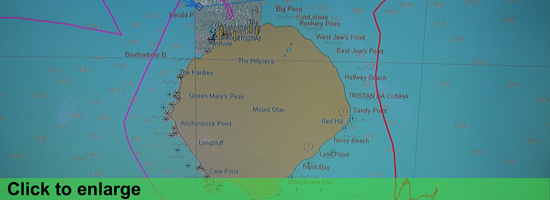
Video News Ocean Journey The Oosterschelde
Video News Ocean Journey The Oosterschelde
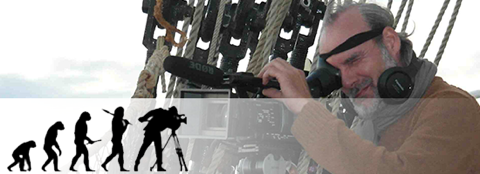
Route Brazil - South Africa 1st of April 2013 - May 2nd, 2013
Assignment: a video journal of a long ocean voyage about the life and atmosphere on board for six weeks . A Dutch three-masted tallship
The Oosterschelde from 1918 on a world trip along continents and historical VOC routes, from Rotterdam to Rotterdam.
After 26 years a former classmate from the Academy of Journalism nosed out that I, as journalist-filmmaker, live in Brazil and submitted me the following challenge ...
For a 13-episode documentary series for Dutch television we are looking for an adventurous director-videographer who can film independently, interview and edit on board. “You will do it for the adventure, because budget is tight, but expenses are paid and we will feed and accommodate you onboard”.
Well... a typical once-in-a-lifetime opportunity... crossing the Atlantic on an old Dutch schooner …. ?
A quick look at my calendar for the next few months , a few phone calls to my customers with long-term film projects ... and the decision came in an instant wink .. I grab my suitcase and prepare my camera kit !
Santos (BR) - Cape Town (SA)
This ocean voyage is known as one of the longest and hardest routes that the Oosterschelde carries on this world of 1,5 years. The route takes from the subtropical waters of Santos towards South Africa’s Cape Town, around the Cape of Good Hope. During this long crossing the authentic Dutch three-master must stand various challenges, the conjunction of two trade – currents; the tropical trade wind meets cold trade from Antarctica on the 35th and 40th parallel .. and that guarantees fierce storms and high waves, and all at an ocean depth of 5 kilometres.
Total distance of up to 3,500 miles, or 6,880 kilometres. This requires a strong western wind which should bring the three-master towards its eastern destination. But to find it, one must navigate to get there.
But before Cape Town will be reached, a secure check of the list needs to be done of what to bring. For more than a month at sea with full gear , you cannot afford to forget that one charger or cable!
Check... Enough batteries, rain gear for the camera , lens cleaner for the inevitable salt deposits, sufficient terrabites on the backup disks, since I will be shooting each day and everything in full HD.
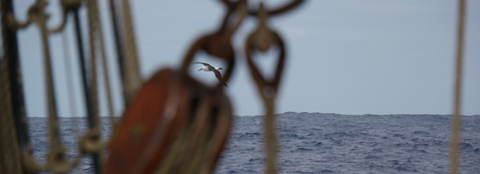
STORM
Just 50 kilometres off the coast of Santos, I already get my pick, force 9, rising to 10 Bft ... and that means storm!
Not knowing how often we were going to go through such a hell , I film just to be sure ... at least, as much as possible to maintain your standing and to avoid the big waterspouts across the deck. Filming on board a sailing ship
under those circumstances, staring through your viewfinder, provides a different perception of the reality around you. And that's tricky. Everything that is not fixed on lower and upper deck, thunders from baking to starboard.
And that goes for me as well, because ‘man overboard' really means overboard, and no one who can save you.
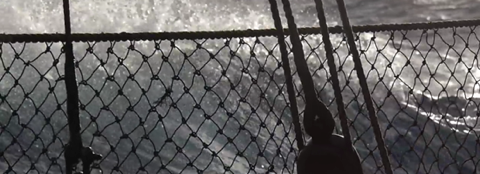
MOST REMOTE ISLAND IN THE WORLD
Highlight of the trip; halfway through the journey is the world's most remote island of Tristan da Cunha. With 2,265 miles on the map a stopover is scheduled here. The volcanic mountain in the middle of nowhere measures only 15 square kilometres and 2,060 meters high, counts just 260 inhabitants in almost complete isolation.
This colonial island that was discovered by the Portuguese in 1505 but eventually annexed two centuries later by the British. The island has a reputation of a ship graveyard, because the almost impassable coast and waves here over the centuries costs a lot of shipwrecks . If I succeed to go ashore, I 'm going to get a stamp in my passport first.
LAND IN SIGHT
After 15 days at open sea .. finally .. land in sight. It would be strange to feel land underneath your feet again. But unfortunately .. our party is negated by the local authorities of Tristan. The weather is not cooperating. It's too dangerous to dock at the island. So after a full day and night to float around in the hope that it would clear again around, we finally set sail for Cape Town . Disappointment among the guests and crew, but for me moments again for nice shots and quotes for the script.
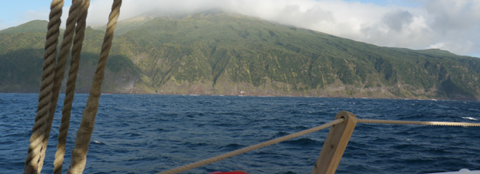
Standing up editing
At the end of the day when people are asleep or on a watch, I upload my footage to the backup. My cabin is not big enough for a small editing set installation, so sometimes you stand in front of your marine cage or improvise a quiet spot below deck to spot and assemble an edit timeline.
The days that follow to Cape Town under favourable weather conditions I interviewed the 12-member guest and 6 crew. Interesting to hear from each about his or her background for this project and their passion for ocean sailing.
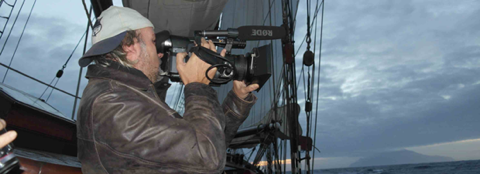
KILL YOUR DARLINGS
After more than a month, at a beautiful dawn we see the first outlines of the South African coast… Cape Town... we made it! The storms that would follow repeatedly during the trip, I and my gear overcome.
For the upcoming 15-minute episode I have more than enough terra bites of shots. So now up to the final montage and 'Kill your Darlings ...’
Filmmaker – director Ernst Daniel Nijboer
Visuals Studio Brazil
video:
mentioned:
Visuals Studio Brazil
TallShip de Oosterschelde
Tristan da Cunha
Authorization for Filming in Brazil
Authorisation for Filming in Brazil

Foreign companies that want to film in Brazil need special documentation to do so legally. Read the article to learn what documentations are needs to be provided to act within the law when filming.
Foreigners who intend to make news reports, films, recordings or capture moving images in Brazil (with or without sound) have to previously ask for ANCINE's authorisation. ANCINE is short for Agência Nacional de Cinema, the national movies agency that is responsible for inter-mediating at the Brazilian diplomatic missions abroad, the requests for proper visa concession for technicians and artists, so they can participate in filming in the country.
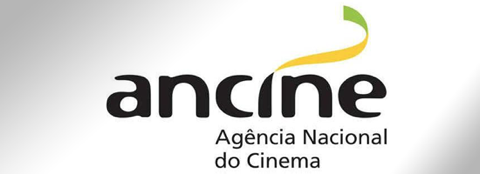
How to Request Authorisation
Apart from foreign journalistic productions, all of the others have to contact a Brazilian production company that will make contact with ANCINE. First, the Brazilian company communicates with ANCINE about its interest and responsibility in making the films or recordings, through a form available in this link. It’s also necessary to present the following documentation:
• Copy of the contract between the foreign production company or person that is legally responsible for the production, and the Brazilian production company, and should indicate the mutual responsibilities, form of payment and the expiration date of the contract.
• Copy of the translated contract mentioned, if it was written in a foreign language.
• Provisional plan of filming/recording, indicating the dates and the places (Municipality/Federal Unit) in the Brazilian territory where the works will happen.
• Copy of the identification sheets of the passport of each one of the foreign workers.

The Brazilian company will be the one responsible for making the customs clearance of all the temporary material used for the production, giving full support to the foreign company.
Any alterations in the originally established conditions have to be reported to ANCINE through a form available in this link. It’s also necessary to present the following documentation:
• Change in the Brazilian diplomatic mission to which the visa request is destined.
• Inclusion or exclusion of technicians and artists.
• Deferral/alteration in the temporary stay term of the technicians and artists in the country.
• Change in the places where the filming/recording will take place.
• Cancellation of the authorised activity.
The visa is issued abroad, on the Brazilian diplomatic missions, once ANCINE approves the concession of visa and provisional stay in the country.
The validity of the visa is determined by the mission, according to the length duration of the filming/recording chronogram.
It may also be necessary to ask for an authorization from CET, the Companhia de Engenharia de Tráfego, which is the Traffic Engineering Department, in case the filming is happening in some street. There are different authorisations in this case, whose prices vary from BRL 148.95 to BRL 1,747.45. The complete table of services is available in Portuguese, here, under the title “Filmagem, fotografia, produção de audiovisuais e similares”, which is filming, photography, audiovisual production and similar.
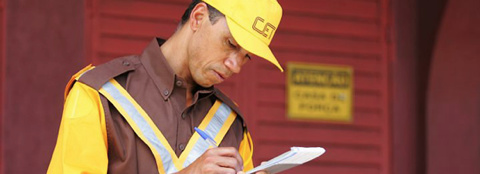
Some cities may have specific forms which must be filled in order to provide the authorization for filming, which must be checked at the City Halls.
Journalistic Productions
The production of foreign audiovisual journalistic works have to be communicated straight to the Brazilian diplomatic missions abroad, so that the proper authorisations can be issued. In these cases, the people going to Brazil to work can apply for a temporary visa as foreign newspaper, radio, television or agency correspondents. There may be internal demands, for instance, a special authorisation to film in a hospital, but these are local specifications, not migratory ones, and need to be checked in the specific places where the filming will occur.
A big thank you goes to our friends at The Brazil Business who were so kind letting us use this very informative post.
Be sure to check the Broadcast Brazil Facebook page and LIKE us.
Lot's of news, photo's and info for broadcasters, webcasters and mobile producers in Brazil.

